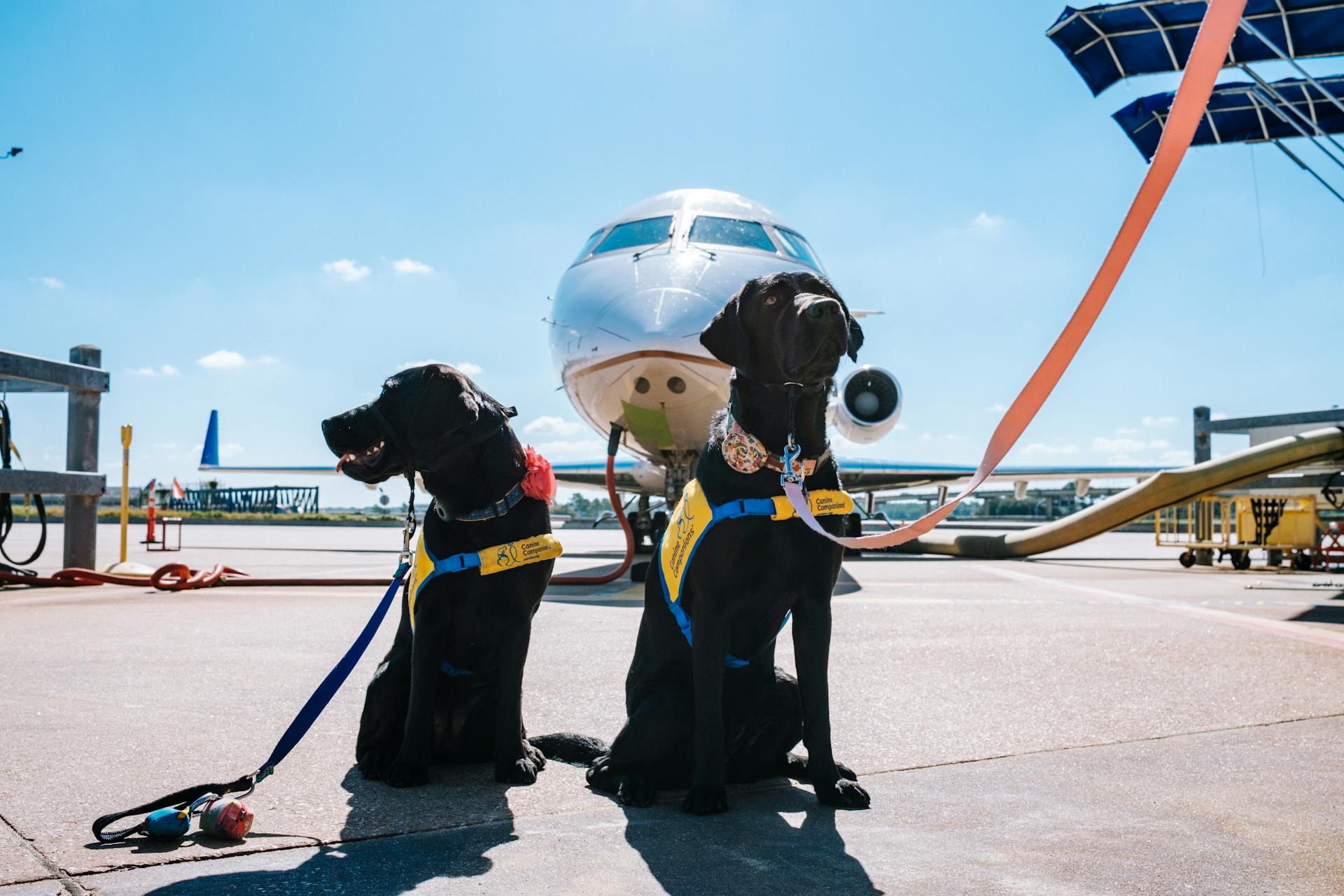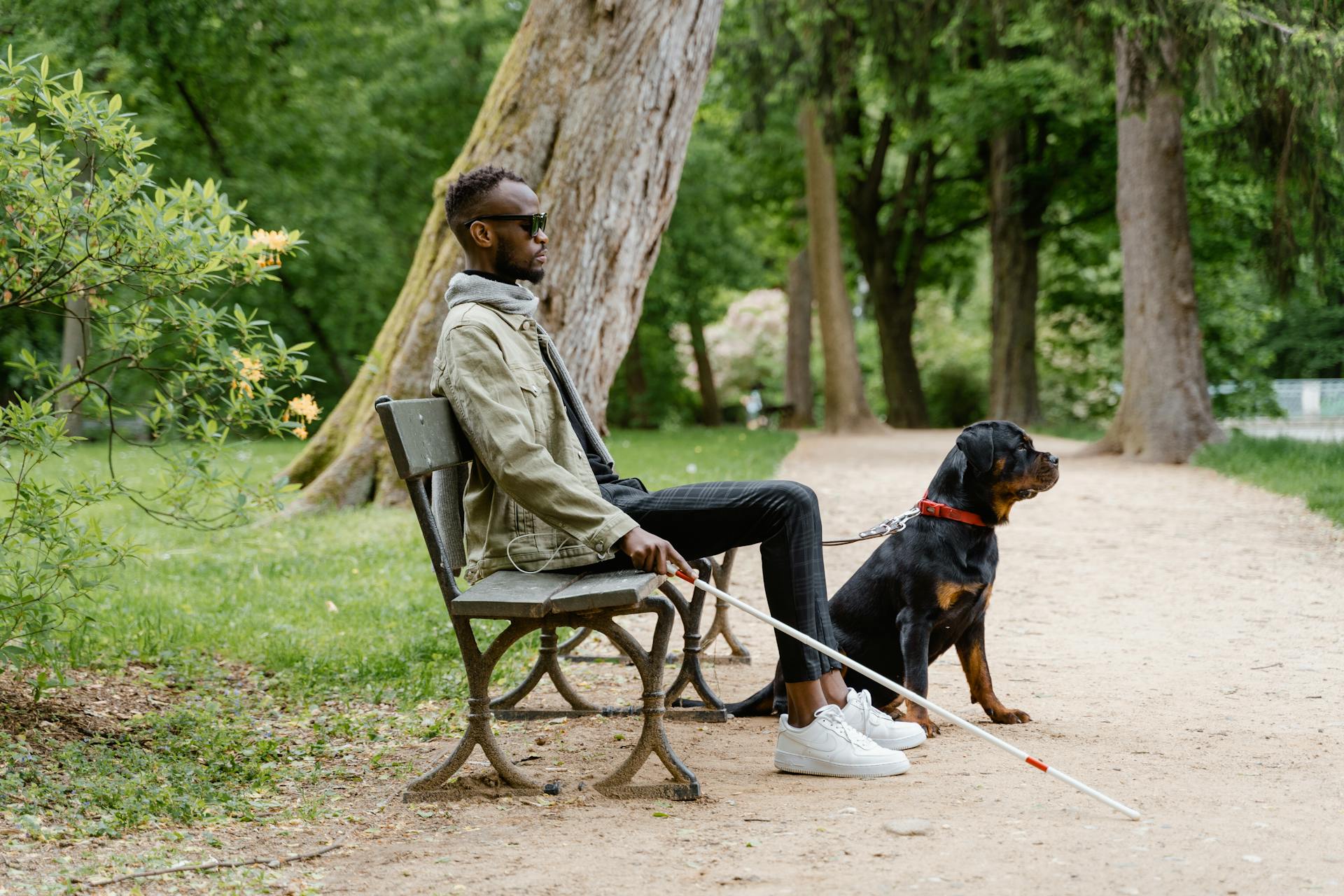
Training a deaf and blind dog requires patience and creativity, but with the right approach, it's definitely possible. Start by using positive reinforcement techniques, such as clicker training, to help your dog associate certain actions with rewards.
A deaf dog can still hear vibrations and feel movements, so use these cues to your advantage. For example, you can use a vibrating collar or a gentle tug on the leash to signal your dog to come or sit.
It's essential to establish a routine and use consistent hand signals and touch cues, as a blind dog relies heavily on touch and spatial awareness. A consistent routine will help your dog feel more secure and confident.
By understanding your dog's unique needs and adapting your training approach accordingly, you can build a strong bond and help your deaf and blind dog thrive.
Related reading: In Touch Dog Training
Training a Blind Dog
Blind dogs can still smell and taste, which are crucial for rewarding them while potty training. This means you can use treats and food-driven cues to guide them to the pet potty.
To train a blind dog, you can play to their strength by using hand cues, which are clear enough for them to follow. For example, you can use a specific hand signal to indicate it's time to go potty.
Using scents can also be a great way to train a blind dog. You can use the scent of treats, or even certain plants or oils, to signal appropriate spaces for going potty. This can be especially helpful if your dog is having trouble navigating their surroundings.
Potty training a blind dog requires patience and consistency. Stay calm and focused, and your dog will follow suit. With time and practice, they'll learn to associate the scents and cues with going potty in the right place.
Here are some tips for training a blind dog:
- Use hand cues to signal it's time to go potty.
- Utilize scents like treats, plants, or oils to signal appropriate spaces.
- Stay patient and consistent, and your dog will learn to follow.
Training a Blind Deaf Dog
Training a blind deaf dog requires patience and consistency, just like training any dog. A strong sense of smell and taste can be used to reward good behavior, making potty training possible.
To play to your dog's strength, use hand cues for deaf dogs and sound cues for blind dogs. Food-driven dogs can be motivated by the smell of treats, while the taste of a reward can be enjoyed by all dogs regardless of ability. A loving pet or two can also be a great affirmation for deaf and blind dogs.
For a blind and deaf dog, using scents can be a helpful way to signal appropriate spaces for going potty. Consider using natural pee pads like Bark Potty, which offer a unique smell and texture that dogs are drawn to.
For another approach, see: Service Dogs for Blind People
Yes Command
Teaching the "Yes" Command can be a bit tricky, but it's a crucial part of training a blind deaf dog. You'll need to choose a signal that your dog can understand and respond to.
For example, you can use a thumbs up to mark good behavior, which means your dog will get a treat. Give your dog a thumbs up and a treat over and over again until he figures out that thumbs up means good job.
Discover more: Sit Means Sit Dog Training Collar
Alternatively, you can try two light taps on the head to mean good job. This is especially helpful for a blind and deaf dog who can't see or hear the signal. As soon as your dog gets two taps on the head, he gets a treat.
For a blind dog, you can simply say "yes" to mark the behavior. This is a straightforward way to let your dog know he's doing something right.
Additional reading: Two Week Dog Training Camp Cost
Down
Training a blind deaf dog requires patience and creativity. You'll need to use hand signals and positive reinforcement to teach them new commands.
To start, you'll need to lure the dog into a down position. This can be done by taking a treat and moving it down towards the ground, encouraging the dog to follow.
For a deaf dog, it's essential to use distinct hand signals that can be easily recognized from a distance. You may need to lure your dog several times until they understand what you want them to do.
Discover more: Deaf Dog Training near Me
As your dog becomes more comfortable with the command, you can start to phase out the treat. Simply give the hand signal and positive marker, and your dog will learn to associate the two.
For a blind and deaf dog, the process is slightly different. You'll start by luring the dog into a down position, then give two taps between the shoulder blades as a signal. This is followed by two taps on the chest and a treat.
It's okay if your dog doesn't understand the command right away. Let them figure it out on their own, and be patient as they learn.
Here are some key steps to keep in mind when teaching a blind deaf dog to go down:
- Lure the dog into a down position using a treat.
- Give two taps between the shoulder blades as a signal.
- Follow with two taps on the chest and a treat.
- Phase out the treat and use the hand signal and positive marker instead.
Importance of Training
Training a blind deaf dog requires a unique approach, one that leverages their other senses to communicate and build trust.
Some dogs are born deaf and blind, and begin to explore the world from the start with their other senses. Consistent dog training can increase your dog's trust in you.
Take a look at this: Blind Dog Training
Training your dog does more than just teach them how to 'sit' or 'stay'. You'll use touch, smell, and taste to communicate with them.
For a blind deaf dog, training can give them the confidence they need to safely navigate their world with a trusted friend. Commands for most dogs are usually verbal or visual using your voice or hand signals.
Importance of Training
Training your dog does more than just teach them how to 'sit' or 'stay'. Consistent dog training can also increase your dog's trust in you, and strengthen your bond.
For a blind deaf dog, training is crucial to give them the confidence they need to safely navigate their world with a trusted friend.
Since blind deaf dogs perceive the world using touch, smell, and taste, you'll use these senses to communicate with them.
Many methods of dog training involve a command, the desired behavior, and then a reward upon the performance of that behavior.
Intriguing read: Blind Deaf Dog with Dementia
Training a Special Needs
Training a special needs dog requires some adjustments, but it's definitely possible with patience and consistency.
Food-driven dogs can be trained using the smell of treats, which is clear enough for deaf dogs. The taste of a reward can be enjoyed by all fur babies, regardless of ability.
Utilizing scents can be a great way to train blind dogs. For example, the smell of certain plants or pet-safe oils can be helpful cues for our furry ones who aren't able to rely on their eyesight.
Be patient and stay consistent – potty training can be challenging for any dog, but it's no less true for special needs pups. The good news is that the process isn't altogether different for a blind or deaf dog than it is for those who don't have these issues.
Here are some tips to help you train your special needs dog:
- Use hand cues for deaf dogs and sound cues for blind dogs.
- Use natural pee pads, like Bark Potty, which offer a unique smell and texture that dogs are drawn to.
- Offer more textural cues to help your furry one find the pet potty.
Training your dog does more than just teach them how to 'sit' or 'stay'. Consistent dog training can also increase your dog's trust in you, and strengthen your bond.
Sources
- https://barkpotty.com/blogs/bark-blog/potty-training-for-blind-or-deaf-dogs
- https://briargatevets.com/news/teach-dog-tricks
- https://wagwalking.com/daily/how-to-train-a-blind-deaf-dog
- https://deafdogsrock.com/deaf-blind-dog-training-time-to-create-your-own-morse-code
- https://www.arcticspiritrescue.org/blog/training-special-needs-dogs/
Featured Images: pexels.com


